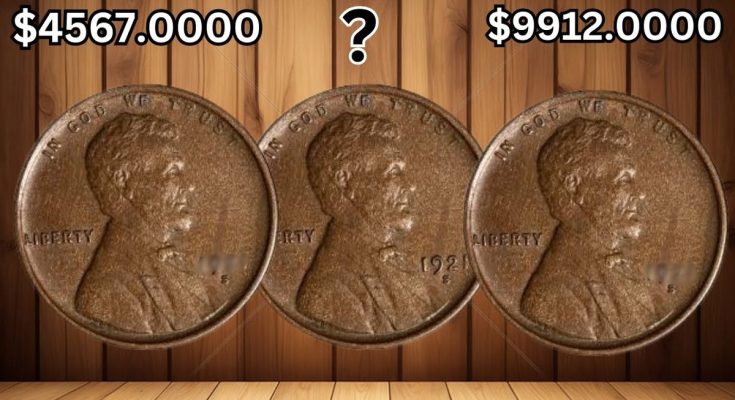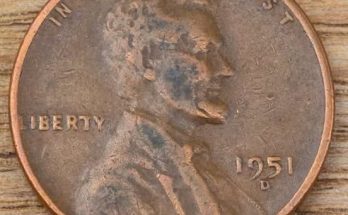Description
Could a simple penny in your pocket change your life forever? Believe it or not, some rare U.S. pennies are worth thousands — even millions — of dollars to collectors. The image above shows three old Lincoln wheat pennies, each representing a potential hidden treasure that might be sitting in your change jar right now. These small copper coins may look ordinary, but certain dates, mint marks, and minting errors make them incredibly valuable in the numismatic world.
The Lincoln Wheat Cent, first introduced in 1909, is one of the most beloved and widely collected coins in American history. Designed by Victor David Brenner, the coin features President Abraham Lincoln on the obverse (front) — the first U.S. coin to bear the likeness of a real historical person. The reverse design, with two stalks of wheat flanking the words “ONE CENT,” was intended to symbolize prosperity and national growth. These pennies were minted from 1909 until 1958, when they were replaced by the Lincoln Memorial design.
During those decades of production, billions of wheat cents were made, but only a handful stand out as true rarities. Their extraordinary values come from a combination of minting mistakes, limited production runs, and specific metal compositions that make them highly sought after. Among these, some of the most famous include the 1909-S VDB, the 1914-D, the 1922 No D, and the 1943 Bronze Cent — each capable of turning up in circulation and instantly transforming an ordinary finder into a very happy collector.
In the photo, the coins appear to include 1921 and 1922 Lincoln Wheat cents, both of which can be extremely valuable depending on specific characteristics. For instance, the 1922 “No D” penny (from the Denver Mint) is one of the most celebrated errors in U.S. coin history. In 1922, only the Denver Mint produced pennies — but due to a worn-out die, some coins were struck without the visible “D” mint mark. These “No D” coins are so rare that collectors will pay thousands of dollars for well-preserved examples. Some have sold for $10,000 or more at auction.
Meanwhile, other early 1920s wheat cents can fetch impressive prices when found in exceptional condition, especially those with a sharp strike, rich color, and little to no wear. Collectors and grading companies like PCGS (Professional Coin Grading Service) and NGC (Numismatic Guaranty Company) use a detailed grading scale from 1 to 70, where higher numbers mean better condition. A coin that looks like it just came from the mint — known as “Mint State” — can command many times the price of a well-worn example.
It’s also worth noting that minting errors can turn even common pennies into rare collectibles. Some of the most valuable errors include:
-
Double die strikes, where the design appears doubled.
-
Off-center strikes, where part of the coin’s design is missing.
-
Clipped planchets, where a piece of the coin’s edge is missing.
-
Wrong metal errors, such as a copper penny struck on a steel or silver planchet.
One of the most famous wrong-metal coins is the 1943 Bronze Wheat Cent. During World War II, copper was needed for ammunition, so the U.S. Mint switched to making pennies out of steel coated with zinc. However, a few copper planchets accidentally remained in the machinery and were struck with 1943 dies. These ultra-rare 1943 bronze cents have sold for over $1 million, with one specimen bringing in nearly $2 million at auction.
That’s why images like this one — showing pennies with values of $4,567, $9,912, and an unknown middle coin marked with a question mark — ignite the imagination of collectors and dreamers alike. Somewhere out there, an old coin hiding in a drawer or jar could be the next record-breaking discovery.
If you want to search for these treasures, here’s how to start:
-
Check the date and mint mark — located under the year on the front. Key dates like 1909-S, 1914-D, 1922 No D, 1931-S, and 1955 Doubled Die are top targets.
-
Examine the coin’s weight and material — older wheat cents before 1982 are made mostly of copper (about 3.11 grams), while later ones are copper-plated zinc (about 2.5 grams).
-
Inspect for unusual features — doubling, misalignment, or missing details could signal a mint error.
-
Avoid cleaning your coins. Cleaning reduces their collector value dramatically.
-
Have them graded by a professional service if you suspect you have something rare.
It’s stories like these that keep treasure hunters and hobbyists excited. Every coin tells a story — of history, economy, and artistry — and every once in a while, that story includes a life-changing twist. Whether it’s the 1909-S VDB penny, the 1922 No D, or a rare 1943 bronze cent, these tiny pieces of metal remind us that true value can hide in the most unexpected places.
So, the next time you spot an old wheat penny, don’t ignore it. Grab a magnifying glass and take a closer look — you might just be holding a piece of American history worth a small fortune. After all, as the caption says, you could quite literally “RETIRE IF YOU FIND THIS VERY VERY EXPENSIVE USA PENNY WORTH MILLIONS OF DOLLARS!”



